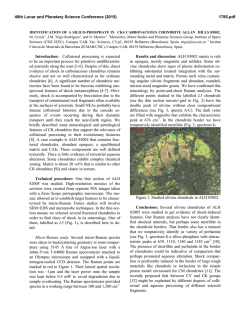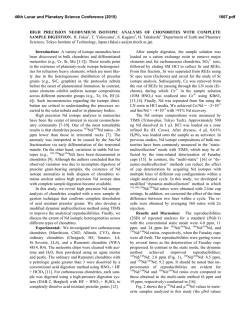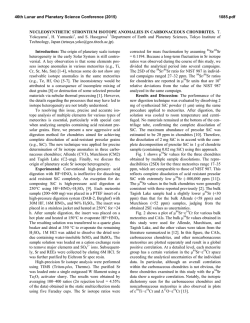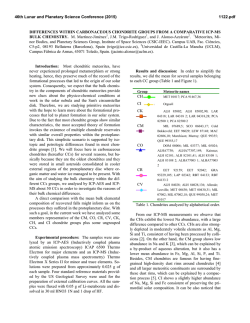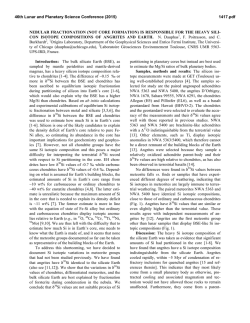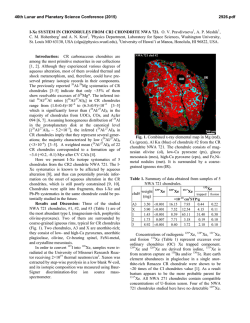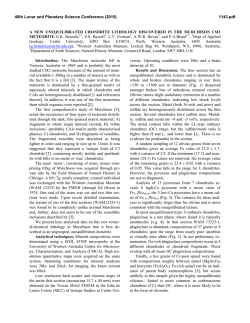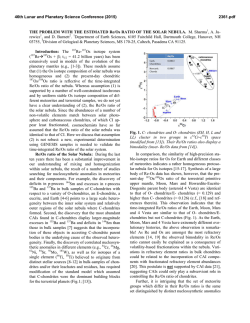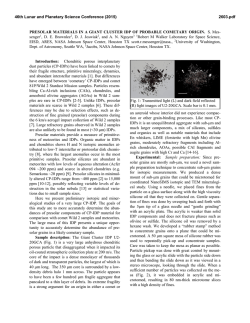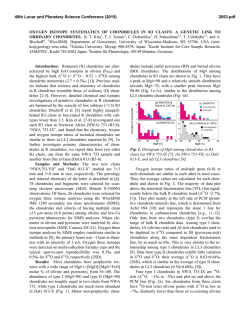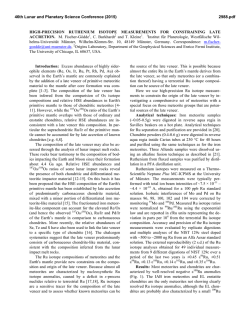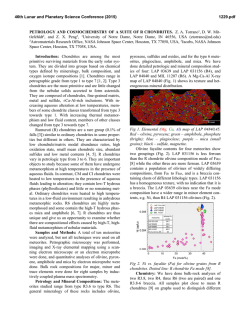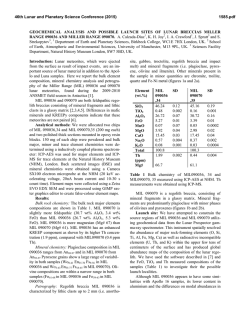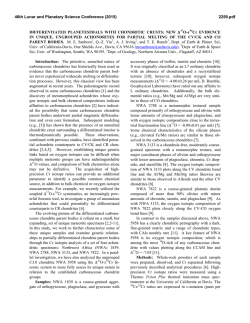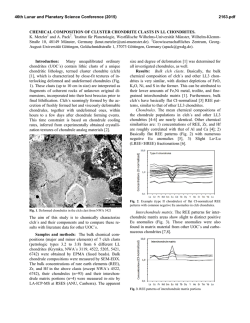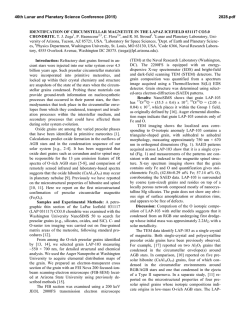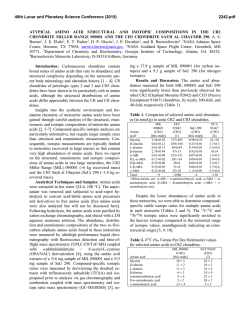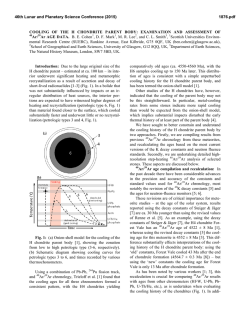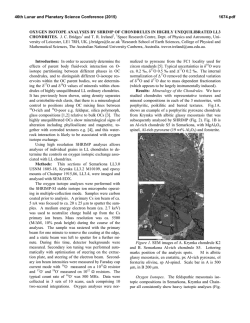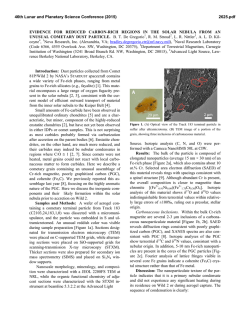
MILLER RANGE 090657: A VERY PRISTINE RENAZZO
46th Lunar and Planetary Science Conference (2015) 1603.pdf MILLER RANGE 090657: A VERY PRISTINE RENAZZO-LIKE (CR) CARBONACEOUS CHONDRITE. J. Davidson1*, C. M. O'D. Alexander1, D. L. Schrader2, L. R. Nittler1, and R. Bowden3, 1Department of Terrestrial Magnetism, Carnegie Institution of Washington, Washington DC 20015, USA, 2National Museum of Natural History, Smithsonian Institution, Washington, DC 20560, USA. 3Geophysical Laboratory, Carnegie Institution of Washington, Washington DC 20015, USA *E-mail: [email protected] Introduction: After interplanetary dust particles, the Renazzo-like (CR) carbonaceous chondrites represent some of the most pristine extraterrestrial samples available for study [e.g., 1,2]. The least altered CRs contain abundant presolar grains [e.g., 3], organic matter [e.g., 4], and Fe-rich amorphous silicates [5] that can provide valuable insight into early Solar System conditions and the first stages of parent body processing. The CR chondrites cover the whole range of aqueous alteration, from ~CR3 to CR1, and have been extensively studied by a wide variety of analytical techniques [6]. Queen Alexandra Range (QUE) 99177 and Meteorite Hills (MET) 00426 are two of the beststudied CR chondrites due to their minimally altered nature [2]. Unfortunately their total known weights are relatively small at 31.3 g (MET 00426) and 43.6 g (QUE 99177) [7] so that the opportunities for conducting some types of destructive analyses are limited. As a result, identifying new minimally altered samples is extremely important. A recent isotopic study of the CR chondrites showed that the bulk O-isotope composition of CR2 Miller Range (MIL) 090657 is similar to that of MET 00426 indicating that it is minimally aqueously altered [8]. MIL 090657 has a relatively large total mass of 133.1 g, low weathering grade of Be, and a fracturing grade of A [9]. Thus, MIL 090657 provides an invaluable opportunity to perform coordinated analyses on minimally altered CR chondrite material. We report the H-C-N isotopic compositions of bulk material and extracted IOM, chemical compositional data, presolar grain abundances, and a petrologic description of MIL 090657. The results of this study indicate that MIL 090657 is one of the most pristine CR chondrites analyzed to date. Experimental Methods: Bulk isotopic analysis. A 1 g chip of bulk sample was acquired and crushed to a grain size of <150 µm. Aliquots were then analyzed for the bulk H, C and N after [10], and for the H, C and N in IOM after [11]. Mineralogy and petrology. Analyses were undertaken on thin section MIL 090657,6. Silicate mineral phases were analyzed (Mg, Si, Na, Ti, Mn, Al, Fe, Ni, Cr, and Ca; 15 kV accelerating voltage, 30 nA probe current) with a JEOL 8900 electron microprobe analyzer (EMPA) at Carnegie Institution of Washington (CIW). Metal and sulfide phases were analyzed (Fe, S, Ni, Co, Cu, Cr, Al, P, Si; 15 kV, 20 nA) with a JEOL 8900 EPMA at the Smithsonian Institution. NanoSIMS ion imaging. Matrix areas (~12,000 µm2 total) were subjected to raster ion imaging via highresolution SIMS (NanoSIMS 50L at CIW) using automated mapping routines. A ~1.7 pA Cs+ primary ion beam was used to image 10×10 µm2 areas with a spatial resolution of ~150 nm. In order to locate O- and Canomalous presolar grains and C-anomalous carbonaceous material secondary electrons and 16,17,18O–, 12C2–, 12 13 – 28 – 27 C C , Si , Al16O– were analyzed simultaneously. Results and Discussion: Bulk isotopic compositions. MIL 090657 has a bulk isotopic composition of δ13C = –2.1 ‰ (1.25 wt.% C), δ15N = 183 ‰ (0.078 wt.% N), and δD = 814 ‰ (0.314 wt.% H). This indicates that MIL 090657 is of petrologic type 2.7 according to [12], and more pristine than all other CR chondrites analyzed to date (Fig. 1). Based on their bulk isotopic compositions, MET 00426 and QUE 99177 were recently suggested to be petrologic type 2.6 and 2.4 chondrites, respectively [12]. Fig. 1. The H isotopic composition and C/H ratio of bulk MIL 090657 and other CR chondrites [10,12]. IOM isotopic compositions. MIL 090657 IOM has an isotopic composition of δ13C = –18.5 ‰ (61.8 wt.% C), δ15N = 131.9 ‰ (2.22 wt.% N), and δD = 2716 ‰ (4.36 wt.% H), similar to other CR chondrites [13]. Presolar grain and organic matter inventory. NanoSIMS ion image mapping identified numerous presolar grains (silicate, oxide, and SiC), and three isotopically anomalous carbonaceous regions that are most likely organic matter. In total, 27 presolar Oanomalous (silicate + oxide) grains correspond to an 46th Lunar and Planetary Science Conference (2015) abundance of ~112±25 ppm (errors based on counting statistics [14]), which is similar to abundances reported for the presolar grain-rich CR2 chondrite NWA 852 (116 ppm [15]) but not as high as those in the MET 00426 and QUE 99177 (160–220 ppm [3]). However, as this is based on a relatively small analysis area (~12,000 µm2) more data are needed. Six presolar SiC grains were also identified (40±20 ppm), which agrees with abundances reported for other primitive chondrites [e.g., 16]. Carbonaceous regions have anomalous C isotopic compositions with δ13C up to ~100 ‰, similar to those seen in MET 00426 and QUE 99177 [e.g., 4,17]. Further analyses are planned to determine the Nand H-isotopic compositions of this material. Mineralogy and petrology. The MIL 090657,6 thin section contains abundant large chondrules (<4 mm in diameter), chondrule fragments, and mineral grains in an optically dark matrix. The chondrule population is dominated by FeO-poor (type-I) chondrules (>95%), with fewer FeO-rich (type-II) chondrules (~4%), and rare Al-rich chondrules (<1%), which is typical for a CR chondrite [18]. Type-I chondrules are predominantly forsteritic and relatively homogeneous (Fa0–3). Type-II chondrules are compositionally variable (~Fa16 to Fa56), normally zoned, and contain relict grains. Both low-Ca (predominantly En95–97Fs2–4Wo1; minor amounts of En90–93Fs5–9Wo1-2) and high-Ca pyroxene (Wo7–49) is seen within chondrules. Plagioclase within chondrules has compositions of An76–99. Opaque mineral assemblages (OAs) are found predominantly along chondrule exteriors but also within the interiors of some chondrules. OAs consist of abundant metal (primarily kamacite, minor taenite), sulfide (primarily pyrrhotite, minor pentlandite), and small amounts of magnetite. Isolated olivine grains in the matrix are FeO-rich (~Fa22 to Fa42), and compositionally similar to type-II chondrules. Fig. 2. Standard deviation versus mean Cr2O3 content of ferroan olivine in MIL 090657 and other CR chondrites. Trends for UOCs [19] and CO3s [20] shown for comparison. Additional data from: [2,18,21]. 1603.pdf For the least altered chondrites, it is possible to identify the least thermally metamorphosed samples by determining the Cr content of ferroan olivine [19]. This scheme has been calibrated for the unequilibrated ordinary chondrites (UOCs) [19], CO chondrites [20], and more recently the CR chondrites [18]. Following the procedures of [19], we analyzed the Cr2O3 contents of the centers of ~50 different ferroan olivine grains within type-II chondrules and chondrule fragments in MIL 090657. When compared with data from 15 other CR chondrites [2,18,21], MIL 090657 appears to be less thermally altered than all CR chondrites other than MET 00426 [21] and QUE 99177 [2] (Fig. 2). However, data for MET 00426 and QUE 99177 vary significantly between studies [2, 21 vs. 18]. Regardless, MIL 090657 appears to have experienced very minimal thermal metamorphism (if any). XRD data also presented at this meeting [22] indicate MIL 090657 contains only ~6 vol.% phyllosilicate and 11 vol.% Fe-bearing amorphous material [22], similar to QUE 99177 [5]. The high abundance of amorphous material and low abundance of phyllosilicate further support the minimally altered nature of MIL 090657. VIS/NIR and MIR spectral data for MIL 090657 are also reported at this meeting [23]. Summary: The bulk isotopic compositions, high presolar grain abundances, and chromium content of ferroan olivine all indicate that MIL 090657 is a very pristine CR2.7 carbonaceous chondrite that has experienced very minimal (if any) thermal processing. References: [1] Weisberg M. et al. (1993) GCA 57, 1567. [2] Abreu N. M. and Brearley A. J. (2010) GCA 74, 1146. [3] Floss C. and Stadermann F. (2009) GCA 73, 2415. [4] Floss C. et al. (2014) GCA 139, 1. [5] Howard K. T. et al. (2015) GCA 149, 206. [6] McBride K. et al. (2013) LPSC XLIV, #2325. [7] Satterwhite C. and Mittlefehldt D. (2001) AMN 24(2). [8] Schrader D. L. et al. (2014) EPSL 407, 48. [9] Satterwhite C. and Righter K. (2012) AMN 35(2). [10] Alexander C. M. O'D. et al. (2012) Science 337, 721. [11] Alexander C. M. O'D. et al. (2010) GCA 74, 4417. [12] Alexander C. M. O'D. et al. (2013) GCA 123, 244. [13] Alexander C. M. O'D. et al. (2007) GCA 71, 4380. [14] Gehrels N. (1986) ApJ 303, 336. [15] Leitner J. et al. (2012) ApJ 745, 38. [16] Davidson J. et al. (2014) GCA 139, 248. [17] Le Guillou C. and Brearley A. J. (2014) GCA 131, 344. [18] Schrader D. L. et al. (2015) MAPS, doi.10.1111/maps.12402. [19] Grossman J. N. and Brearley A. J. (2005) MAPS 40, 87. [20] Davidson J. et al. (2014) LPSC XLV, #1384. [21] Berlin J. (2009) Ph.D. Thesis, Uni. New. Mexico. [22] Howard K. T. et al. (2015) LPSC XLVI, this volume. [23] McAdam M. M. et al. (2015) LPSC XLVI, this volume.
© Copyright 2026
